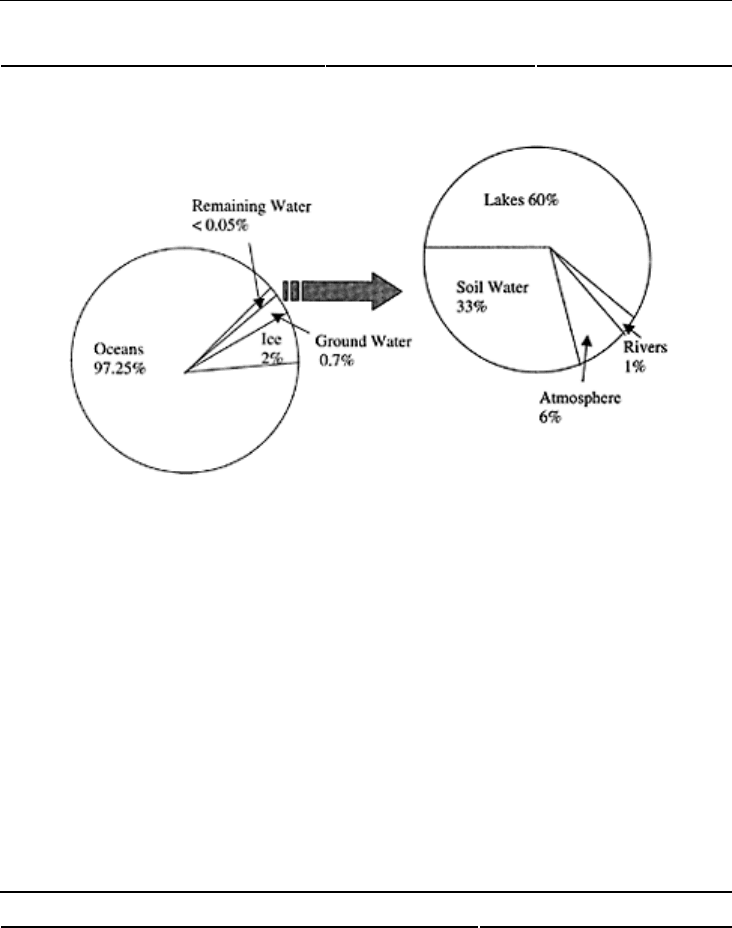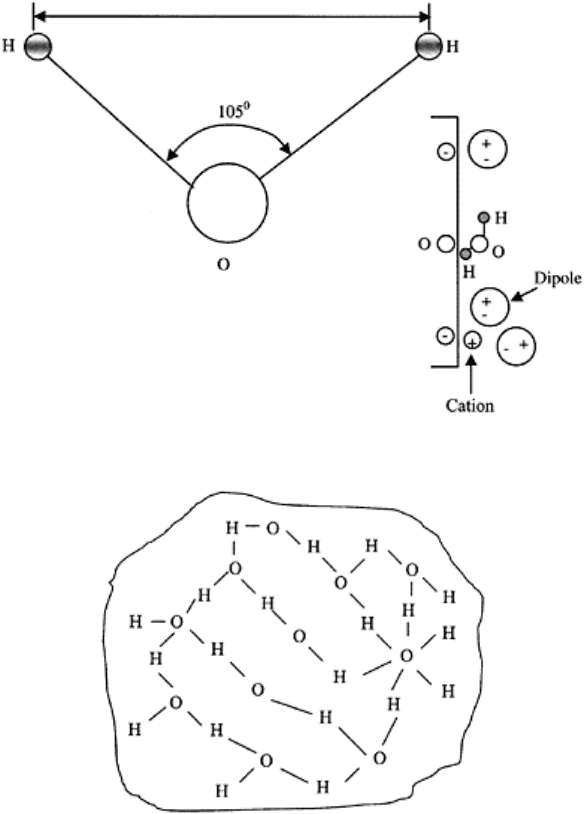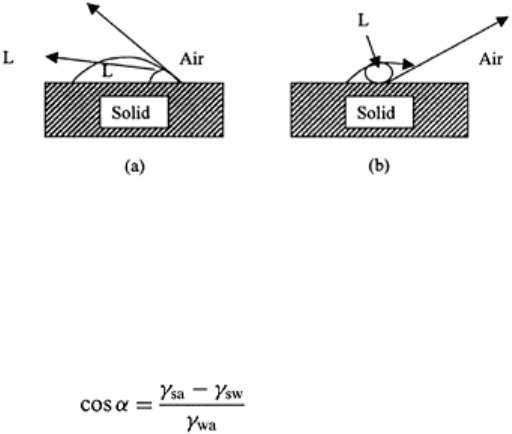Lal R., Shukla M.K. Principles of Soil Physics
Подождите немного. Документ загружается.


9
Water
The hydrosphere, with a strong influence on the pedosphere, comprises the sum total of
all water bodies (oceans, rivers, lakes), groundwater (renewable and fossil), and soil
water. Although water is the most abundant of all resources covering 70% of the earth’s
surface, freshwater is a scarce resource. The data in Table 9.1 indicate that 97.2%
(volume basis) of the world water is in oceans and seas (1370 M Km
3
). Freshwater
accounts for merely 2.8% of the total volume, of which groundwater is 0.6%, and soil
water accounts for less than 0.1% of the total (Fig. 9.1).
Soil is a major reservoir of freshwater, which accounts for about 50 times that in rivers
and streams (Table 9.1). Some hydrologists classify the freshwater pools using simple
nomenclature that reflects their functional characteristics. For example, blue water refers
to water in water bodies that is lost from the land as runoff or seepage flow. This is the
water that is temporarily lost for use by humans, animals, or plants. Freshwater, usable by
primary producers (and comprising soil water, groundwater, and other irrigable sources),
can be termed green water. The fraction of freshwater that is lost to the atmosphere
through direct and soil evaporation may be termed red water. Fossil water is difficult to
assess, is not renewable, and may be termed gray water. While simple and easy to
comprehend, such terminology is vague, subjective, and arbitrary.
TABLE 9.1 Global Water Resources
Reservoir/Pool Quantity (Km
3
) Percent of total
Water bodies
Oceans 1,370,000,000 97.2
Freshwater lakes 125,000 <0.1
Saline lakes and inland areas 104,000 <0.1
Rivers and streams 1,300 <0.1
Ice sources
Polar ice cap and glaciers 29,200,000 2.2
Lithosphere
Soil water 67,000 <0.1

Groundwater 8,350,000 0.6
Atmosphere 13,000 <0.1
Source: Nace, 1971; Edwards et al., 1983; Goldman and Home, 1983; Van der Leeden et al., 1990;
Alley et al., 2002.
FIGURE 9.1 Different types of natural
water.
9.1 PROPERTIES OF WATER
Principal properties of H
2
O relevant to soil physical properties and processes are listed in
Table 9.2. Some specific properties are described below.
9.1.1 Water Molecule
A single water molecule has a radius of 1.38 Å, at the center of which lies the oxygen
nucleus. The oxygen and hydrogen protons in the water molecule
TABLE 9.2 Properties of Water Relevant to Soil
Physical Properties and Processes
Property Value
Density at 20°C 998.20 Kg m
−3
Density at 3.98°C 1000.0 Kg m
−3
Viscosity at 0°C 1.787 centipoise
Viscosity at 20°C 1.002 centipoise
Water 235

Surface tension against air at 0°C 75.6 dynes cm
−1
Surface tension against air at 20°C 72.75 dynes cm
−1
Boiling point at NTP 100°C
Freezing point at NTP 0°C
Heat of vaporization 590 cal g
−1
Heat of freezing 80 cal g
−1
Source: Adapted from Weast, 1987.
are about 0.97 A apart, and hydrogen protons are about 1.54 A apart. Two hydrogen
atoms are at an angle of about 105° from each other (Fig. 9.2), giving water an electric
dipole of about 1.87×10
−18
esu.
The dipole moment produces electric field in the vicinity of each molecule. The
electric field of adjacent water molecules creates an attractive force creating relatively
weak intermolecular hydrogen bond between the proton of the hydrogen atom of one
molecule and the oxygen atom of the other. Therefore, water molecules are joined
together through hydrogen bonding (Fig. 9.3). These bonds are weaker than covalent
bonds.
One mole of water, about 18 cm
3
(18 g), contains 6.02×10
23
molecules. Therefore, 1
cm
3
of water contains 3.3×10
22
individual molecules. When water crystallizes at 0°C, it
develops an open crystalline structure. Therefore, ice is less dense than liquid water at the
same temperature because water expands on freezing. It is this expansion of water on
freezing that causes changes in soil structure by repeated cycles of freezing and thawing
(refer to Chapter 4).
Water has a very high boiling point, a very high melting point, and low density in the
liquid phase (Table 9.2; see also Appendix 9.1). The liquid water molecules are freer to
move, and they have greater internal energy. About 80 calories (334 joules or 3.34×10
8
ergs) of heat energy per g of water is liberated when water changes from liquid to solid.
Therefore, the entropy of water is higher in the liquid than in the more orderly crystalline,
or solid state. The heat of vaporization of water, the heat absorbed to change from liquid
to vapor state, is about 590 calories (2463 joules, or 2.45×10
9
ergs) per g of water.
Therefore, entropy of water is higher in the vapor than in the liquid state (see Chapter
17).
Principles of soil physics 236

FIGURE 9.2 Water adsorption.
FIGURE 9.3 Water molecules joined
together through hydrogen bonding.
9.1.2 Surface Tension
Water molecules at the air-water, solid-water, or another fluid-water interface are
subjected to different forces than molecules within the bulk volume of the fluid. Water
molecules within the bulk volume are hydrogen bonded to adjacent molecules and the
cohesive forces are the same in all directions. At the air-water interface (or solid-water
Water 237

interface), the force pulling into the air is much different than force within the bulk
volume. For a molecule on the surface, there is a resultant attraction inward (Fig. 9.4).
FIGURE 9.4 Forces acting on a
molecule resting inside the liquid (A)
and on the surface (B). The molecule
on the surface has an unbalanced force
making the water surface behave like a
stretched membrane.
This imbalance in the force has the net effect of pulling the molecules in the one or two
molecular layers near the surface into the bulk volume. The result is an orientation of
molecules at the surface in such a way that pressure beneath the surface is much greater
than above it, the surface behaves as if it were a stretched membrane, and the surface of
the liquid always tends to contract to the smallest possible area. That is why the drop of
liquid and bubbles of gas in a liquid become spherical. For a sphere, the surface is
minimum for the given volume. In order to extend the surface, work has to be done to
bring the molecules from the bulk of the liquid into the surface against the inward
attractive force. This is called free surface energy. The difference in pressure is the cause
of surface tension (γ), which is expressed in units of force per unit length or dynes/cm.
If a solid is immersed in water, the interfacial tension is due to the forces of adhesion
(e.g., the forces of attraction for the water molecules by the solid and vice versa). These
forces are the reasons for the work to be done to separate the solid from the liquid. The
amount of work required is given by Eq. (9.1).
(9.1)
The work (W
sw
) is expressed in units of energy, and γ
sa
, γ
wa
, and γ
sw
represent surface
tension at the solid-air, water-air, and solid-water interfaces, and A
s
is the area of the solid
surface. Eq. (9.1) is called the Dupré equation (1969).
9.1.3 Contact Angle
Soil is a three-phase system: solid, liquid, and gas (see Chapter 2). Assuming that two
fluid phases (liquid and gas) are in contact with soil solid, the
Principles of soil physics 238

FIGURE 9.5 Angle of contact (a) is
acute in a liquid that wets the solid,
and (b) is obtuse in a liquid that does
not wet the solid (L refers to liquid).
interface between air and water, forms a definite angle called the contact angle (Fig. 9.5).
This angle is determined by Eq. (9.2) or Young’s equation.
(9.2)
The contact angle α thus depends on three interfacial tensions. However, whether it is
acute (<90°) depends on the relative magnitude of γ
sa
and γ
sw
. If γ
sa
exceeds γ
sw
, then cos α
is positive, and α is less than 90°. This is generally the case with most mineral soils and
water, because water wets soils. If γ
sw
exceeds γ
sa
, then cos α is negative, and α is
between 90° and 180°. This is the case of mercury and soil, because mercury does not
wet the soil. When the liquid wets the solid (soils) the contact angle is acute and the
liquid meniscus is convex, when it does not, the contact angle is obtuse and the meniscus
is concave (Fig. 9.5).
Hydrophilic Versus Hydrophobic Soils
If the adhesive forces between the soil and water are greater than the cohesive force
inside the water, and greater than the forces of attraction between the air and the soil, then
the soil-water contact angle is acute and water will wet the soil. Therefore, hydrophilic
soil can be defined as having the following characteristics:
Adhesive force (water-soil) >cohesive force (water-water) >adhesive force
(soil-air)
A contact angle of zero implies complete flattening of the drop and perfect wetting of the
soil surface by the water, and soil has absolute preference for the water over air.
A contact angle of 180° would mean a complete nonwetting or rejection of the water
by the air-full soil. The water drop would retain its spherical shape without spreading
over the soil surface.
When water is wetting the soil, the contact angle is low or acute. This low angle is
called “wetting” or “advancing” angle. When the soil is drying and the water film is
receding, the contact angle is different. It is called “receding” or “retreating angle.” This
Water 239

difference in wetting and retreating angle is also the cause of soil-water hysteresis, which
will be discussed in Chapter 10. Soil hydrophobicity is affected by some organic
substances coated on aggregate surfaces, such as in the case of the formation of algal
crust. In such cases, the angle of contact can be modified through management. Plowing
and physically rupturing the crust can improve wetting. In irrigated soils, wettability can
be improved by use of surfactants.
9.1.4 Capillarity
A capillary tube in a body of water forms a meniscus as a result of the contact angle of
water with the walls of the tube. The curvature of this meniscus will be greater (i.e.,
radius of curvature smaller), the narrower the tube (Fig. 9.6a vs. 9.6d). The height of
capillary rise depends on the diameter of the section that corresponds with the pressure
difference (Fig. 9.6b vs. 9.6c). Because of the difference in the contact angle, the water
rises in the glass tube but mercury falls in the glass tube (Fig. 9.7).
A liquid with an acute angle will have less pressure inside meniscus than atmospheric
pressure [Eq. (9.3)].
P
i
<P
o
(9.3)
For a capillary of uniform radius r, at equilibrium the forces per unit area pulling down.
(9.4)
FIGURE 9.6 Rise of water in capillary
tubes of different diameters.
Principles of soil physics 240

FIGURE 9.7 Angle of contact for (a)
glass and water is acute (<90°), and (b)
glass and mercury is obtuse (>90°).
(9.5)
At equilibrium
πr
2
hρ
w
g=2πrγ cos α
(9.6)
(9.7)
(9.8)
where ∆P is the pressure difference across the interface. Eq. (9.8) is the equation of
Young and Laplace for a spherical surface. If the contact angle between solid and liquid
is zero (glass, mineral soil particle) than Eq. (9.8) is as simple as Eq. (9.9).
(9.9a)
(9.9b)
(9.9c)
Equations (9.8) or (9.9a) state that as a consequence of the existence of surface tension at
a spherical surface of radius of curvature r, mechanical equilibrium is maintained
between two fluids (water and air in soil) at different pressures.
Water 241

Substituting the appropriate values for H
2
O at 20°C in Eq. (9.9c) (γ=72.75 dynes/cm
or g/s
2
, ρ
w
=0.9982 g/cm
3
, and g=980 cm/s
2
), we can solve for r assuming that α is zero
[Eq. (9.10)].
r=(0.1487/h) cm
(9.10)
Soil being an extremely heterogeneous mass, there are numerous radii to influence the
pressure across the water film. In Figs. 9.6b and c, there are two radii to be considered.
The radius (r) is within the liquid phase and forms a convex surface. If the bubble is not
spherical and has two principal radii (r
1
and r
2
), and assuming that the contact angle is
zero, the pressure difference across an interface with two principal radii is given by Eq.
(9.11).
(9.11)
The rise or fall of liquids in capillary tubes is used to calculate the pore size distribution
(Chapter 6). Whether a liquid rises in a glass capillary (as water) or is depressed (as
mercury) depends on the relative magnitude of the forces of cohesion (between the liquid
molecules themselves) and the forces of adhesion (between the liquid and the wall of the
tube). These forces determine the contact angle α.
The occurrence of a concave meniscus leads to the capillary rise, whereas a convex
meniscus leads to capillary depression. As soon as the concave meniscus is formed, the
pressure in the liquid under the curved surface is less than the pressure in the air. The
liquid thus rises in the tube until the weight of the liquid column just balances the
pressure difference (∆P=2γ/r) and restores the hydrostatic equilibrium. The liquid
column acts as a manometer to register the pressure difference across the meniscus.
Example 9.1
What is ∆P at the surface of a droplet of water and mercury with r of 1 mm?
Solutions
(a) For the air-water interface
(b) For the mercury-air interface=8600 dynes/cm
2
The difference calculated across the interface does not refer to the difference due
to vapor pressure, which may be substantial.
Example 9.2
Principles of soil physics 242

What vacuum is needed to draw all the water out of a sintered glass funnel if the
minimum pore size is 4 µm in diameter?
Solution
As the water is withdrawn from the pores, the maximum pressure is reached when a
hemispherical bubble is formed with a radius just equal to that of the pore. Therefore, the
∆P=(2γ/r)=2(72.75 dynes/cm)/2×10
−4
cm=72.75×10
4
dynes/cm
9.1.5 Osmotic Pressure
Osmotic pressure is a property of solutions, expressing the decrease of the potential
energy of water in solution relative to that of pure water (see Chapter 20).
When an aqueous solution is separated from pure water (or from a solution of lower
concentration) by a membrane that is permeable to water alone, water will tend to diffuse
or osmose through the membrane into the more concentrated solution, thus diluting it or
reducing the potential energy difference across the membrane. The osmotic pressure is
the counter pressure that must be applied to the solution to prevent the osmosis of water
into it.
In dilute solutions, the osmotic pressure is generally proportional to the concentration
of the solution and to its temperature according to Eq. (9.12).
P
s
=KTC
s
(9.12)
where P
s
is osmotic pressure, T is absolute temperature, and C
s
is concentration of solute.
An increase in the osmotic pressure is usually accompanied by a decrease in the vapor
pressure, a rise of the boiling point, and a depression of the freezing point.
9.1.6 Solubility of Gases
The concentration of gases in water generally increases with pressure and decreases with
temperature. According to Henry’s law, the mass concentration of gas C
m
is proportional
to the pressure of gas P
i
[Eq. (9.13)].
(9.13)
when C
m
is mass concentration of gas, S
c
is solubility coefficient of the gas in water, P
i
is
pressure of the gas, P
o
is total pressure of the atmosphere, and C
m
is mass of dissolved
gas relative to the mass of H
2
O. The volume concentration is similarly proportional to Eq.
(9.14).
(9.14)
Water 243
